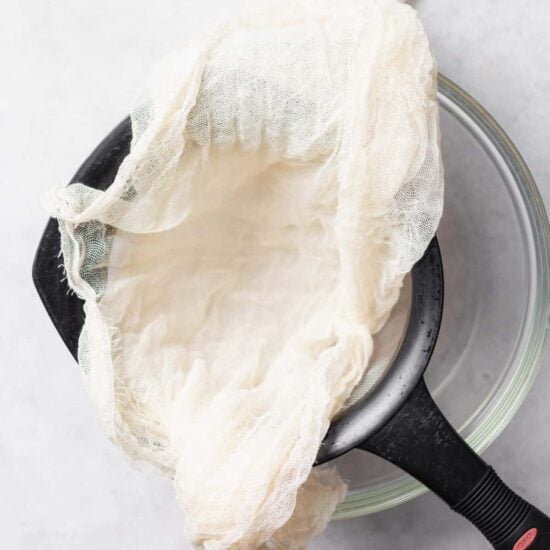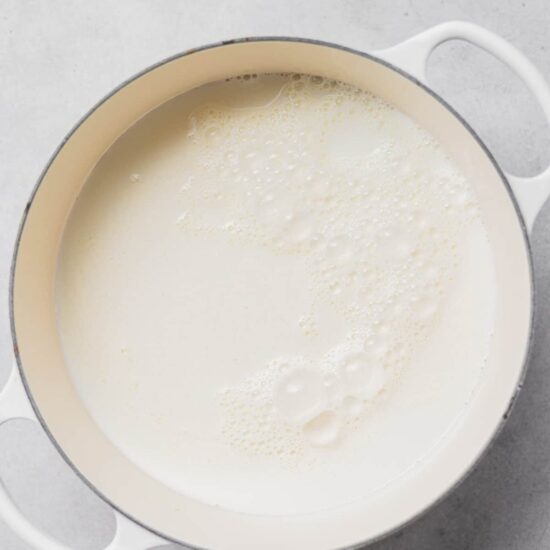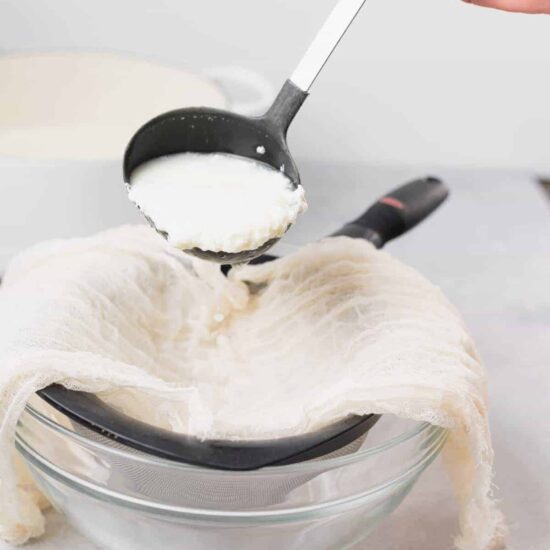
How to Make Ricotta Cheese
This homemade ricotta cheese recipe is made using whole milk, whipping cream, white vinegar, and kosher salt.
Prep 5 minutes
Cook 40 minutes
Total 45 minutes
Fat 12
Carbs 8
Protein 12
Yield 5
Ingredients
- 1/2 gallon whole milk 3.25% fat (make sure it's fresh and not ultra-pasteurized, UHT)*
- ½ cup whipping cream 35% fat
- 3 tablespoons white vinegar
- ½ teaspoon kosher salt
Instructions
- First, prepare your colander by lining it with cheesecloth. Fold the cheesecloth over itself 3 or 4 times, using a piece of cloth large enough to completely cover the colander with some overhang. Wet the cheesecloth and wring it out, and then place it over the colander in the bowl. Set aside.

- Add all of the milk, cream, and salt to the saucepan and slowly heat the mixture over medium heat to 192 degrees F (88 degrees C) – this should take 15-20 minutes. Stir occasionally to make sure the milk does not scorch. Remove the saucepan from the heat, and stir in all of the vinegar.

- Cover the pot and allow it to rest for 15 minutes.
- Gently ladle the ricotta into the cheesecloth-lined colander. Once all of the curd and whey has been ladled into the colander, allow to drain. The final consistency of the ricotta will depend on how long it drains. For a creamy ricotta, drain for 5-7 minutes. For a drier ricotta, drain for up to 20 minutes.

- Use the ricotta immediately, or transfer to a container and refrigerate for up to a week.
Tips & Notes
- whole milk - make sure you use fresh whole milk. If your milk says ultra-pasteurized (UHT) on the carton, do not use it.
- storage - will last in the refrigerator for up to 1 week.
- freezer instructions - transfer into an airtight container and freeze for up to 1 month. To use, let thaw overnight in the fridge.
- This recipe yields 2.5 cups.
- Homemade ricotta cannot be made with ultra-pasteurized milk, as the curd will not set. Read the label on your milk to make sure it isn’t ultra-pasteurized
- Make sure your homemade ricotta is sufficiently drained for using in baking or as a filling for pasta. Watery ricotta could alter the desired outcome of your recipe
- Wash your cheesecloth well in diluted bleach water, and let it hang to dry. You can reuse cheesecloth many times!
- The longer you let your ricotta cheese strain, the drier it will be. Drier ricotta is great for baking (you'll notice that a lot of baking recipes require you to strain before baking) and the less you strain, the more creamy it will be.
Nutrition Facts
Calories: 180kcal | Carbohydrates: 8g | Protein: 12g | Fat: 12g | Fiber: 0g | Sugar: 4g